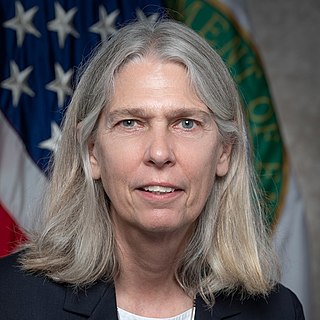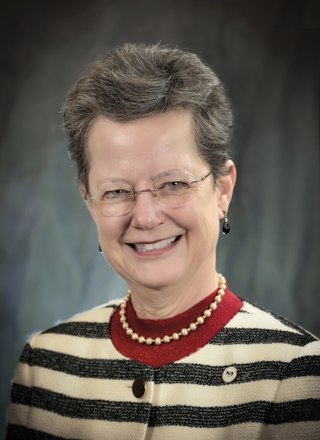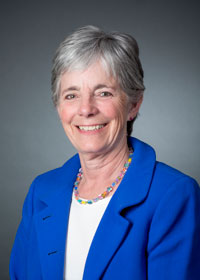
Los Alamos National Laboratory is one of the sixteen research and development laboratories of the United States Department of Energy (DOE), located a short distance northwest of Santa Fe, New Mexico, in the American southwest. Best known for its central role in helping develop the first atomic bomb, LANL is one of the world's largest and most advanced scientific institutions.
Lawrence Livermore National Laboratory (LLNL) is a federally funded research and development center in Livermore, California, United States. Originally established in 1952, the laboratory now is sponsored by the United States Department of Energy and administered privately by Lawrence Livermore National Security, LLC.

The United States Department of Energy (DOE) is an executive department of the U.S. federal government that oversees U.S. national energy policy and energy production, the research and development of nuclear power, the military's nuclear weapons program, nuclear reactor production for the United States Navy, energy-related research, and energy conservation.

Pacific Northwest National Laboratory (PNNL) is one of the United States Department of Energy national laboratories, managed by the Department of Energy's (DOE) Office of Science. The main campus of the laboratory is in Richland, Washington.

Sandia National Laboratories (SNL), also known as Sandia, is one of three research and development laboratories of the United States Department of Energy's National Nuclear Security Administration (NNSA). Headquartered in Kirtland Air Force Base in Albuquerque, New Mexico, it has a second principal facility next to Lawrence Livermore National Laboratory in Livermore, California, and a test facility in Waimea, Kauai, Hawaii. Sandia is owned by the U.S. federal government but privately managed and operated by National Technology and Engineering Solutions of Sandia, a wholly owned subsidiary of Honeywell International.

Argonne National Laboratory is a federally funded research and development center in Lemont, Illinois, United States. Founded in 1946, the laboratory is owned by the United States Department of Energy and administered by UChicago Argonne LLC of the University of Chicago. The facility is the largest national laboratory in the Midwest.

The United States Department of Energy National Laboratories and Technology Centers is a system of laboratories overseen by the United States Department of Energy (DOE) for scientific and technological research. The primary mission of the DOE national laboratories is to conduct research and development (R&D) addressing national priorities: energy and climate, the environment, national security, and health. Sixteen of the seventeen DOE national laboratories are federally funded research and development centers administered, managed, operated and staffed by private-sector organizations under management and operating (M&O) contracts with the DOE. The National Laboratory system was established in the wake of World War II, during which the United States had quickly set-up and pursued advanced scientific research in the sprawling Manhattan Project.

Idaho National Laboratory (INL) is one of the national laboratories of the United States Department of Energy and is managed by the Battelle Energy Alliance. Historically, the lab has been involved with nuclear research, although the laboratory does other research as well. Much of current knowledge about how nuclear reactors behave and misbehave was discovered at what is now Idaho National Laboratory. John Grossenbacher, former INL director, said, "The history of nuclear energy for peaceful application has principally been written in Idaho".

The Institute of Nuclear Materials Management (INMM) is an international technical and professional organization that works to promote safe handling of nuclear material and the safe practice of nuclear materials management through publications, as well as organized presentations and meetings.
The Advanced Fuel Cycle Initiative (AFCI) is an extensive research and development effort of the United States Department of Energy (DOE). The mission and focus of AFCI is to enable the safe, secure, economic and sustainable expansion of nuclear energy by conducting research, development, and demonstration focused on nuclear fuel recycling and waste management to meet U.S. needs.

Katherine "Kathy" Anne Yelick, an American computer scientist, is the vice chancellor for research and the Robert S. Pepper Professor of Electrical Engineering and Computer Sciences at the University of California, Berkeley. She is also a faculty scientist at Lawrence Berkeley National Laboratory, where she was Associate Laboratory Director for Computing Sciences from 2010–2019.

Nancy Beth Jackson was an American chemist. She did energy research on heterogeneous catalysis and the development of alternative fuels. She also worked in the field of chemical nonproliferation, educating chemical professionals on the importance of safe and secure chemical practice in research, teaching and business, in an effort to prevent the misuse of chemicals as "weapons, poisons, explosives or environmental pollutants". She was the first implementer in developing the international Chemical Security Engagement Program. She was active in promoting diversity in STEM fields. She was president of the American Chemical Society in 2011, leading the organization during the International Year of Chemistry. In 2012, she was honored with the AAAS Award for Science Diplomacy.

Terry C. Wallace Jr. is an American geophysicist. He was the 11th director of Los Alamos National Laboratory and the president of Los Alamos National Security, LLC. He became director on January 1, 2018, succeeding Charles F. McMillan.

Deborah A. Frincke is an American academic and computer scientist specializing in computer security who is the associate laboratories director of national security programs at Sandia National Laboratories.
Susan Sharpless Hubbard is an American hydrologist and geophysicist, and Hubbard is the Deputy for Science and Technology at Oak Ridge National Laboratory. She was elected a member of the National Academy of Engineering in 2020 for contributions to hydrogeophysics, biogeophysics, and the geophysics of permafrost.

Jill M. Hruby is an American mechanical engineer and government official. Since July 26, 2021, Hruby has served as Under Secretary of Energy for Nuclear Security and Administrator of the National Nuclear Security Administration, a post subject to Senate confirmation. Jill Hruby made history as the first woman to ever head a U.S. nuclear weapons lab, serving as director of Sandia National Laboratories from 2015-2017.

Julia Mae Phillips is an American physicist. She began her career in materials research on thin films on semiconductors and has transitioned into leadership roles in science policy. She currently serves on the National Science Board.
Christine Anne Coverdale is an American plasma physicist at Sandia National Laboratories, where she is a Distinguished Member of the Technical Staff.

Susan Joyce Seestrom is an American experimental nuclear physicist and physics administrator, the Chief Research Officer at Sandia National Laboratories. Before moving to Sandia, she was the first female head of the Physics Division and the Weapons Physics Directorate at the Los Alamos National Laboratory, and she became the first female chair of the Nuclear Science Advisory Committee of the Department of Energy and National Science Foundation. She is known for her research on neutrons and particularly on ultracold neutrons.
Miriam E. John is an American engineer who is a policy advisor and former vice president of Sandia National Laboratories. She is an expert in nuclear weapons and chemical defence. In 2022, she was awarded the Lawrence Livermore National Laboratory John S. Foster, Jr. Medal and was elected Fellow of the National Academy of Engineering.















